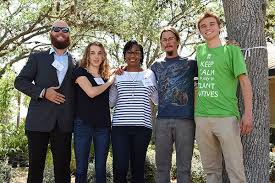The slash pine, also known as Pinus elliottii is a fast-growing evergreen tree. The splash pine generally in this area is 50 to 60 feet tall and about 30 to 35 feet wide. It likes full sun and part sun environments and can grow in soils as different as loam, sand, or even occasionally wet types of soils. But one of the most important things is that it needs an acidic pH level, which means it can’t be in a highly alkaline environment.
So it’s really cool to note that pine trees are different than our flowering species. So flowering trees, obviously having flowers, pine trees are in a family of trees called the conifers or the gymnosperms essentially meaning a naked seed.
The difference between a pine tree and a regular flowering tree is that pine trees have male and female cones. So the large cones that you see are actually the female parts of the plant and the male part is a small cone that actually releases pollen. Conifers being a little bit different is that they use the wind to actually pollinate the female cone with the male pollen.
A few really easy ways to identify a slash pine, one of them being with the needles. So these needles are arranged in what are also called fascicles. Generally you’re going to find them in groups of two needles or even sometimes three needles. They’re going to be between six and 12 inches long. This one’s about six to eight inches. This one’s about eight to 10 but 12 inches max, and the smallest they’ll get is about six inches.
Another great way to identify slash pines is the cone. Generally the cone is going to be two, three, four inches at the most about six inches. And this is the female cone. It’s important to understand that we don’t have the male cone here right now, but the male cone is a lot smaller. So this is the female cone and it’s cool because this portion actually opens up and on the inside here is a sticky resin that actually helps to capture the pollen from the male cone. But another easy way to identify it, it’s going to be about yay big four inches, six inches at the most.
Another great way to identify slash Pines in our area is the very beautiful, deeply plated reddish to Brown bark. You’ll see it in pretty large plates that have these little furrow separated and it’s cool to note that in between these furrows and underneath them are different little spots where insects can hide, which is one of the reasons why birds like it so much because there’s lots of different insects you can eat. There’s even what we call it, a little bagworm moth off hanging out right here. I’ve even found scorpion sometimes hiding underneath these, so these are really important aspects of the wildlife value of it and another great way to identify them.
Wildlife Value
Pine trees offer a host of benefits to wildlife. One of them is the cover that they provide for lots of different species, especially our native bird species. It’s also really important to note that older trees should be left alone and eventually will become what we call snags, which is a dead tree that cavity-nesting birds absolutely need to be able to survive and breed.
Some of these examples include great horned owls and different species of woodpeckers. Also, different types of animals, including turkeys and some small mammals will actually eat the cone and the fruit that’s located inside of the cone.
Landscape Uses
This is a great tree to plant in your yard if you’re looking for a naturalistic look, but the pine tree alone has a beautiful, very Regal look to it already. It can also be used in groupings and then different native plants can be used around it. Things like Saul, Paul meadow, a beauty Berry, different types of wildflowers. It’s also cool to note that the needles over time will actually increase the acidity of your soil, and it creates kind of a shifting sun type of shade, which is really great for things like azaleas, chameleons, Dogwood, a lot of those acid-loving flowering plants that like that shifting shade type of environment.
Thank you guys so much for being a part of this plant profile of Slash Pines. So leave a comment down below. Let us know what you think, or if you have any other ideas of anything else that we can cover in the future.

